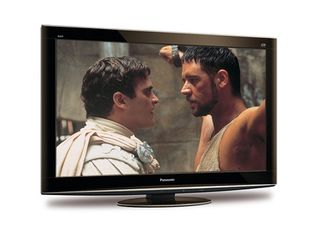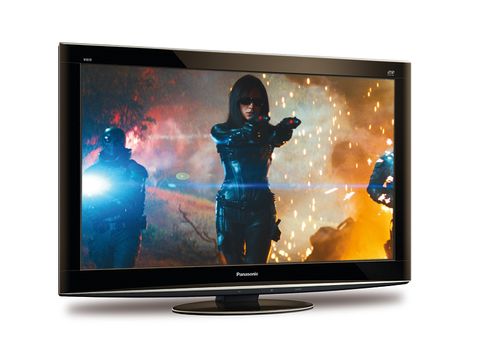Why you can trust TechRadar

As alluded to in the overview, this TV packs in more technology than an Airbus A380, ticking just about every box on most TV buyers' wishlist.
With dual Freeview and Freesat HD tuners there is no danger of missing out on free to air HD programming, although it's hard to imagine anyone buying a set like this who doesn't also have a Sky HD or Virgin Media source with which to bring out the best of its picture-enhancing processing talents.
Of the built-in tuners, the Freesat experience is by far the better of the two but neither of them has a particularly appealing EPG.
EPG
They both exit the live broadcast aurally and visually so you can't follow what you've been watching. The fonts and colours used on both are rather dull, but at least the Freesat EPG doesn't have the ridiculous poster adverts that occupy one side of the screen, thereby reducing the amount of space available for programme listings.
Connectivity is exemplary: there are four v1.4 HDMIs, one of which features an audio return channel; there are also dual USBs, an SD card slot, CI slot for TopUp TV and a LAN port.
One USB could be used for hooking up a Buffalo JustStore Desktop HDD to convert the set in to a quasi-PVR while the other is used to wirelessly connect to a DLNA network using the supplied Wi-Fi dongle.
Networking
Unfortunately, the dongle projects out from the edge of the frame when in place and ruins the clean lines but we did find it worked well, connecting effortlessly to a BT Home hub, Windows 7 netbook and a Twonky portal on an iMac eliminating the need to delve into the confusing world of IP addresses and proxy settings required when making a wired Ethernet connection.
Being able to watch JPEG photos and MP4 videos on such a great screen is a real boon, but resorting to using an SD card or USB flash memory stick hardly seems a great hardship.
Before we know it, 3D will be regarded as a standard feature of most large screen TVs with the focus shifting heavily to internet video, or Smart TV as it now seems to be called. A number of providers are seeking to get involved, offering different on-demand solutions such as Apple TV, Google TV and the BBC-led YouView.
Viera Cast is Panasonic's stab at video content delivered over the internet and compared with what's available from other manufacturers and what's coming in the future it looks like something of a sideshow.
Lack of content
There's no iPlayer and access to a small selection of content from the likes of YouTube, Picasa, Eurosport and Bloomberg make for little more than an interesting diversion, although for Skype users, the built-in app could be handy (and you'd need to buy an optional USB camera).
The P42VT20B boasts an impressive suite of adjustable picture processing tools including CATS, which automatically adjusts the contrast according to the amount of ambient light, and P-NR, which reduces the amount of MPEG noise.
There is the usual selection of picture modes (Normal, Dynamic, Cinema, Game, Photo, THX) plus options to tinker with the white balance, hue, saturation and gamma levels which can be saved as two 'professional settings'. Most users, we suspect, will be more than happy to leave the advanced settings well alone.
TV manufacturers are engaged in a refresh rate war, with LCD screens often boasting 100Hz, 200Hz and even 400Hz processing. This is supposed to make motion smooth, reducing judder and it works to an extent but it has an unwanted side-effect that makes most filmic material look like camcorder video. This hasn't stopped Panasonic from playing the numbers game by conjuring up a 600Hz processing figure.
It's a slightly misleading claim, since the screen doesn't actually refresh itself 600 times per second. By adding 12 sub-fields to each of the 50 frames displayed per second you get a total of 600 'images' per second. Panasonic calls this processing Intelligent Frame Creation or IFC.
Most sources, especially DVB and Freesat, do indeed have a pleasing fluidity to them but as well as the unwelcome video-effect some material suffers from artefacts and haloing.
Another frame-rate side-effect is that a fast moving golf ball can disappear altogether for a few seconds with IFC on. Overall, IFC is worth leaving alone.
Confusingly, when watching a 1080/24p Blu-ray the name IFC disappears from the menu and is replaced by 24p Smooth Film. By any name, IFC should really be avoided.
The P42VT20B is supplied with two pairs of Panasonic's 3D glasses. These come with adjustable nose bridge adaptors and, although they feel comfortable enough, they do let in a lot of orange light, which makes watching 3D almost impossible in a brightly lit room.
Current page: Panasonic TX-P42VT20: Features
Prev Page Panasonic TX-P42VT20: Overview Next Page Panasonic TX-P42VT20: Picture quality
